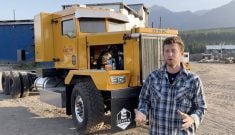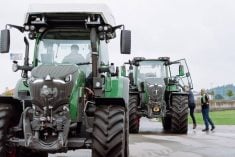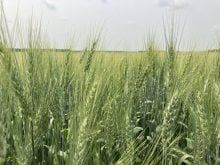The Western Producer has been examining wind power generation in Western Canada, so it’s a good time to introduce a new columnist on the subject of energy.
Which is better, solar or wind?
It’s a question that needs to be qualified: are we talking payback, maintenance, environmental impact or aesthetics?
There is no right answer because it depends on the location and scale of the project, the installed costs of the two technologies and current conventional energy costs.
When thinking of wind, most prairie residents think, “boy, do we have wind.” In truth, wind varies greatly.
Read Also

Gap in emission regulations hamstrings Canadian hybrid truck manufacturer
A B.C. company building hybrid engines for heavy trucks says they have the opportunity to build something leading edge in Canada, but our own laws are stopping them from doing it.
A look at wind maps from a source such as the Canadian Wind Energy Atlas at www.windatlas.ca will show that the wind resource is the greatest in southern Alberta and southwestern Saskatchewan and diminishes moving northeast.
However, every region has atypical pockets that break with the regional trend: valleys, ridges, terrain and bush. The wind maps comprise data for average wind speed. Note that a particular date in the winter has melting temperatures in one year and record cold in another year.
Likewise, average wind speed is made of extremes. If the average wind speed is theoretically 6.5 metres per second, it could comprise wind of 10.5 m/s and 2.5 m/s, each for half of the time.
The quirky thing about wind energy is that doubling the wind speed means eight times the power. Put another way, an increase of only 25 percent in wind speed means almost double the power.
So for higher total production, you want fewer but higher speed winds rather than steady low speed winds.
It is hard to predict wind production at any specific site without expensive testing over several years. Wind can vary greatly from site to site and from year to year.
Wind testing is not typically used for smaller scale residential or farm-sized wind machines. Rather, the experts rely on educated guesses.
Southern Canada has good solar potential and none better than on the Prairies. It is also easier to predict than wind.
Solar maps are accurate and insolation, a measure of solar radiation striking the ground, is less variable from site to site. If you want to put a solar collector in a valley or on a hill, you will not see any difference in power output, provided the panel receives full sunlight.
However, summer to winter variation in solar is dramatic. In the Regina area one can expect six hours of average daily insolation in the summer and 2.5 hours in the winter. As you move north, winter-summer variation is greater.
Wind has long captured the prairie imagination: rusting old wind-driven pumps still dot the landscape.
And now, understandably, there is great fascination with making electricity from something we curse more often than we admire. With a generally good wind resource, we have lots of open spaces with little conflict over turbine placement and concerns about noise.
Wind turbines have been associated with the death of birds and anecdotal concerns about human health. Solar electric panels, called photovoltaics, have no such baggage.
Wind turbines are considered by some to be a blight on the landscape but for others a roof full of reflective panels is considered unsightly.
Comparing wind machines to solar electric panels is a challenge. Solar electric panels are subject to standardized testing, but wind turbines are not. Instead, wind performance data is generally provided by the manufacturer of the specific turbine.
Wind is a strong and potentially dangerous resource. Most wind turbines are capable of handling up to 150 km/h winds.
However, they are mechanical devices subject to strong forces and require annual or semi-annual inspection and maintenance.
They can be installed on self-supporting towers that require a crane and someone to climb up for servicing. Or, they can be installed on tilt-up towers, which enable easier access for servicing.
Most wind turbines come with five year warranties.
Good quality solar panels have warranties that say they will produce at least 80 percent of their rated output after 25 years. Solar panels require little maintenance. Most are covered with tempered glass that can stand a pounding by all but the largest of hailstones before they break.
To maximize annual solar output, solar panels should have a different orientation in summer and winter. In summer, the sun is overhead and the panels can be almost horizontal. In the winter, however, the angle should more vertical so the panel is close to perpendicular to the low angle of the winter light.
Simple panel mounts keep the panels in a southern orientation but allow the angle to be changed from horizontal to steep as the season progresses.
Mechanical devices called trackers will follow the summer sun from the northeast in the morning to the northwest in the evening. They are expensive but can improve production up to 40 percent over stationary panels.
Overall, a solar electric installation will result in less required maintenance than will a wind turbine installation.
It appears as though wind turbines are less expensive per kilowatt hour, but decreasing photovoltaic prices are closing the gap.
The Saskatchewan Research Council administers a grant of 35 percent of capital cost for either a solar or wind power installation in that province, up to a maximum of $35,000 and 100 kilowatts.
However, even with the grant, wind and solar power installations are long-term investments with current returns in the low single digits.
There isn’t a right or wrong choice when it comes to installing a wind or solar power system.
People choose to install systems for various reasons and more often than not, the reason is not saving money in the short term.
The long-term prospect of higher energy costs means the return on investment will become more fruitful as time goes by.
However, some folks are not waiting for the guarantee of better returns. They are simply taking steps to produce renewable energy on their own terms, and the eager world is prepared to consume that power.
Will Oddie is a renewable energy, sustainable building consultant with a lifetime interest in energy conservation(his parents made him turn off the lights).
Trained as a landscape architect, he is an advocate for advanced construction technologies, the reuse of heritage buildings and the wise use of resources.
He and his wife farm organically near Tregarva, Sask., northwest of Regina.
Oddie also works with Kelln Solar of Lumsden, Sask., promoting the use of solar technologies for livestock watering systems, residential power and pool heating.
And yes, for those with long memories, he is the son of long-time Western Producer contributor, Emmie Oddie.
To contact Oddie, send e-mail to energyfield@producer.com.














